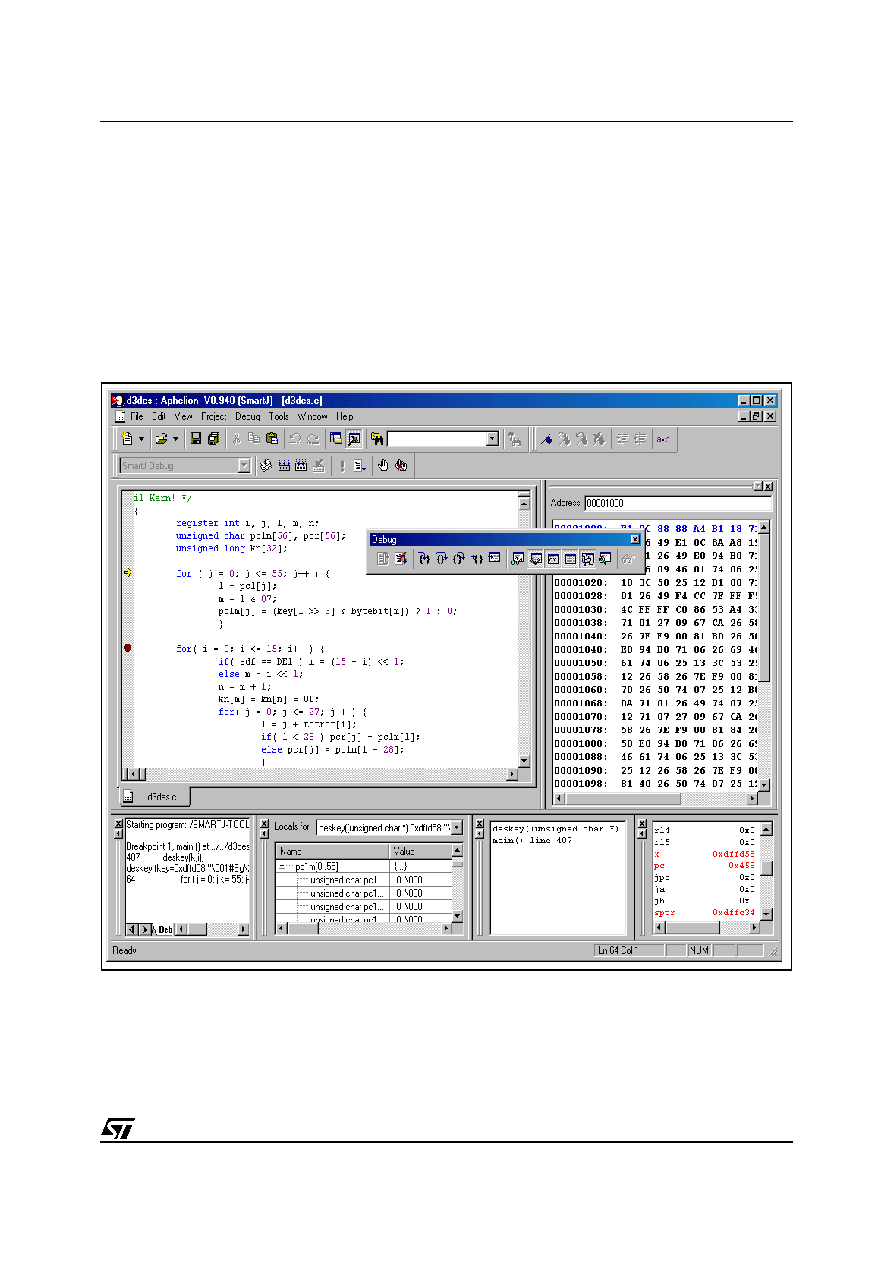
1/7
DATA BRIEF
October 2004
For further information contact your local ST sales office.
ST22N144
Smartcard 32-Bit RISC MCU with 144 Kbytes EEPROM
JavacardTM HW Execution & Cryptographic Library
7
PRODUCT FEATURES
I
32-BIT RISC CPU WITH 24-BIT LINEAR
MEMORY ADDRESSING
I
368 KBYTES USER ROM
I
12 KBYTES USER RAM
I
144 KBYTES USER EEPROM
32-BIT RISC CPU
I
DUAL INSTRUCTION SET, JAVACARDTM
AND NATIVE
I
4-STAGE PIPELINE
I
16 GENERAL PURPOSE 32-BIT
REGISTERS, AND SPECIAL REGISTERS
I
4 MASKABLE INTERRUPT LEVELS
I
SUPERVISOR AND USER MODES
SECURITY
I
CPU SECURITY INSTRUCTIONS
Dedicated instructions for DES and Triple
DES implementation
Dedicated instructions (Multiply and
Accumulate) for efficient implementation
of modular arithmetic and elliptic curves
based cryptosystems
CRC instruction (ISO 3309 16-bit
Checksum)
I
RANDOM NUMBER GENERATOR
I
EEPROM FLASH PROGRAMMING MODE
I
CLOCK AND POWER MANAGEMENT
I
VOLTAGE AND CLOCK FREQUENCY
SENSORS
I
ADVANCED MEMORY PROTECTION
Memory Protection Unit for application
firewalling and peripheral access control
Domain switching securely controlled by
protected Context Stack
Native/Java, Code/Data memory
attributes with 128-byte granularity
I
FOUR WORKING STACKS
Java stack with both 16 and 32-bit
accesses
User and Supervisor mode stacks
Security Context Stack
Figure 1. Delivery Form
4
4
4
4
Micromodule
Wafer

ST22N144
2/7
CRYPTOGRAPHIC LIBRARY
The Crypto Library is provided as a separate ROM
area with an access through a unique entry point.
This library provides optimized -for the SmartJ
core- and secured implementation of the following
features:
I
ASYMMETRICAL ALGORITHMS
RSA signature/verification
Prime number generation (up to 1024-bit)
RSA key computation (up to 2048-bit)
I
HASH FUNCTION
SHA-1
I
SYMMETRICAL ALGORITHMS
DES, Triple DES, AES
CRYPTOGRAPHY PERFORMANCE
The following table provides the cryptographic
performances of the ST22N144 based on ST
Crypto Library.
Table 1. Preliminary Cryptographic
Performances
MEMORY
I
HIGHLY RELIABLE CMOS EEPROM
TECHNOLOGY
Error Correction Code for single bit fail
within a 32-bit word
10 years data retention, 500,000 Erase/
Write cycles endurance
1 to 128 bytes Erase or Program in 2 ms
typical
I
HIGH PERFORMANCE MEMORY
Dual memory buses for data and
instruction
Byte, Short (2) and Word (4) load and
store
Address auto-increment
OTHER FEATURES
I
HARDWARE ASYNCHRONOUS SERIAL
INTERFACE (ASI)
1M baud rate capability
2 serial I/O ports compatible ISO 7816-3
T=0 and T=1
I
2 USER CONFIGURABLE 12-BIT AND 16-
BIT TIMERS WITH INTERRUPT
I
CENTRAL INTERRUPT CONTROLLER
WITH UP TO 16 INPUT LINES
I
EXTERNAL CLOCK FROM 1 MHz TO
10 MHz
I
1.62 V TO 5.5 V SUPPLY VOLTAGE
I
TEMPERATURE RANGE -25° C to +85° C
I
POWER SAVING STANDBY MODE
I
ESD PROTECTION GREATER THAN 5000 V
I
UNIQUE IDENTIFICATION PER DIE
I
TYPICAL INTERNAL FREQUENCY UP TO
33 MHz
I
SOFTWARE CONTROLLED CLOCK
MANAGEMENT
Algorithm
Function
Time
(1)
1. Internal clock at 33 MHz
RSA
1024 bits
Signature with CRT
79.0 ms
Signature without CRT
(2)
2. CRT: Chinese Reminder Theorem
242.0 ms
Verification (e=0x10001)
3.6 ms
RSA
2048 bits
Signature with CRT
485.0 ms
Signature without CRT
1.7 s
Verification (e=0x10001)
11.0 ms
DES
Triple
18 µs
Single
8 µs
SHA-1
512-bit Block
194 µs
AES-128
Encryption including subkey
computation
85 µs

3/7
ST22N144
DESCRIPTION
The ST22N144 is a member of the SmartJTM plat-
form using a 32-bit Reduced Instruction Set Com-
puter (RISC) core to execute both Native RISC
instructions and JavaCardTM 2.x Technology in-
struction (byte codes) directly
(See Figure 2.
"SmartJTM Platform EEPROM Architecture", on
page 3)
.
Direct JavaCardTM byte code execution provides
high performance advantage over processors that
emulate the JavaCardTM byte code instruction set.
The product features a 24-bit wide linear address-
ing capability and includes User ROM, User RAM,
and User EEPROM.
Memory and Peripheral accesses are controlled
by a Memory Protection Unit that allows to imple-
ment firewalls between applications.
Memories are accessed via two different buses,
allowing simultaneous accesses to code and data.
Memory load and stores can be performed at byte,
short (2-bytes), or word (4-bytes) granularity, with
optional pointer auto increment.
The ST22 core includes dedicated instructions to
accelerate performances of the following algoriths:
DES and Triple DES
Modular Arithmetic on big numbers,
Characteristic two field arithmetic to support
efficiently Elliptic Curves,
CRC 16-bit ISO 3309.
The product has clock and power management,
2 User configurable Timers, a Central Interrupt
Controller and a Random Number Generator.
Figure 2. SmartJTM Platform EEPROM Architecture
POWER MANAGEMENT
32-bit
RISC
CORE
CLOCK MANAGEMENT
MPU
RAM
BUS 2
BUS 1
SEC
URIT
Y
TIME
R
RNG
...
...
ASI
PERIPHERALS
ISO
7816
ROM
EEPROM

ST22N144
4/7
The product has two execution modes. Java mode
is used when JavaCardTM 2.x byte codes are be-
ing executed. Native mode is used for long JavaC-
ardTM byte codes, Native methods and system
routines. The processor enters Java mode when a
dispatch (DISP) instruction is encountered. When
executing in Native mode, there are two privilege
levels, User and Supervisor. Some instructions
can only be executed in Supervisor mode.
Instructions are of variable length, from 1 to 4
bytes in Native mode.
Special instructions exist for single-cycle stack op-
erations, a frequent occurrence in Java code.
Short branches and conditional branches within a
1 KByte block or the entire 16-MByte instruction
space are supported. The product has four stages
of pipeline in Native mode: fetch, decode, execute
and write-back. In Java mode, there are five stag-
es of pipeline: byte code-fetch, byte code-decode,
decode, execute and write-back.
The CPU core has 16 32-bit general purpose reg-
isters, as well as special registers of variable
length.
The chip also features a very high performance
Asynchronous Serial Interface (ASI) to support
high speed serial communication protocols com-
patible with ISO 7816 standard.
It is manufactured using the highly reliable ST
CMOS EEPROM technology.
EMBEDDED SOFTWARE
The Hardware Software Interface (HSI) imple-
ments the Hardware abstraction layer. It consists
of C interfaces to the EEPROM memory and pe-
ripherals. The drivers are:
Non Volatile Memory
Asynchronous Serial Interface
Central Interrupt Controller
Timer
Random Number Generator
Clock Manager
Memory Protection Unit
Sensors
Security
Note:
The HSI driver software layer is a C-oriented
API allowing efficient and secure access to the
peripherals and Non Volatile Memory for
programming or erasing.
Only the OS and JavaCardTM Virtual Machine
(JVM) domains can access the HSI software
layer (In the following the term OS will refer to
the software layer that is directly interfaced to
the HSI).
CRYPTOGRAPHIC LIBRARY
ST proposes a complete set of firmware subrou-
tines to allow fast and easy implementation of
cryptographic protocols. These subroutines have
been optimized according to the ST22 core speci-
ficities and dedicated instructions. Security issues
have been addressed to provide state of the art
security. The whole library is located in a specific
ROM area access through a single entry point.
Following features are available through library:
I
ASYMMETRICAL ALGORITHMS:
Basic modular arithmetic for various
lengths including modular product for odd
modulus.
More elaborate functions (with separate
fast and secure versions) such as
exponentiation, RSA signatures and
verifications for modulo length up to
2048 bits long.
Full internal RSA key generation. This
guarantees that the secret key will never
be known outside the chip and will
contribute to the overall system security,
Random number generation of big size,
SHA-1.
I
SYMMETRICAL ALGORITHMS
DES, Triple DES including key schedule,
AES with standalone key schedule for
lenght 128, 192 and 256.

5/7
ST22N144
SOFTWARE DEVELOPMENT ENVIRONMENT
Modularity, flexibility and methodology are the key
words for the SmartJTM Development Tools Plat-
form. Using the same interface, the developers are
able to create, compile and debug a project.
The SmartJTM Integrated Development environ-
ment (IDE) includes:
A code Generation chain: C/C++ compiler,
assembler and linker. The assembler supports
both native and JavaCardTM instruction sets.
An instruction set simulator, a cycle accurate
simulator, a C/C++ source level debugger.
Software and Hardware tools allow to
efficiently generate, then validate all code and
application embbeded softwares for the
SmartJTM platform.
Figure 3. SmartJTM IDE




